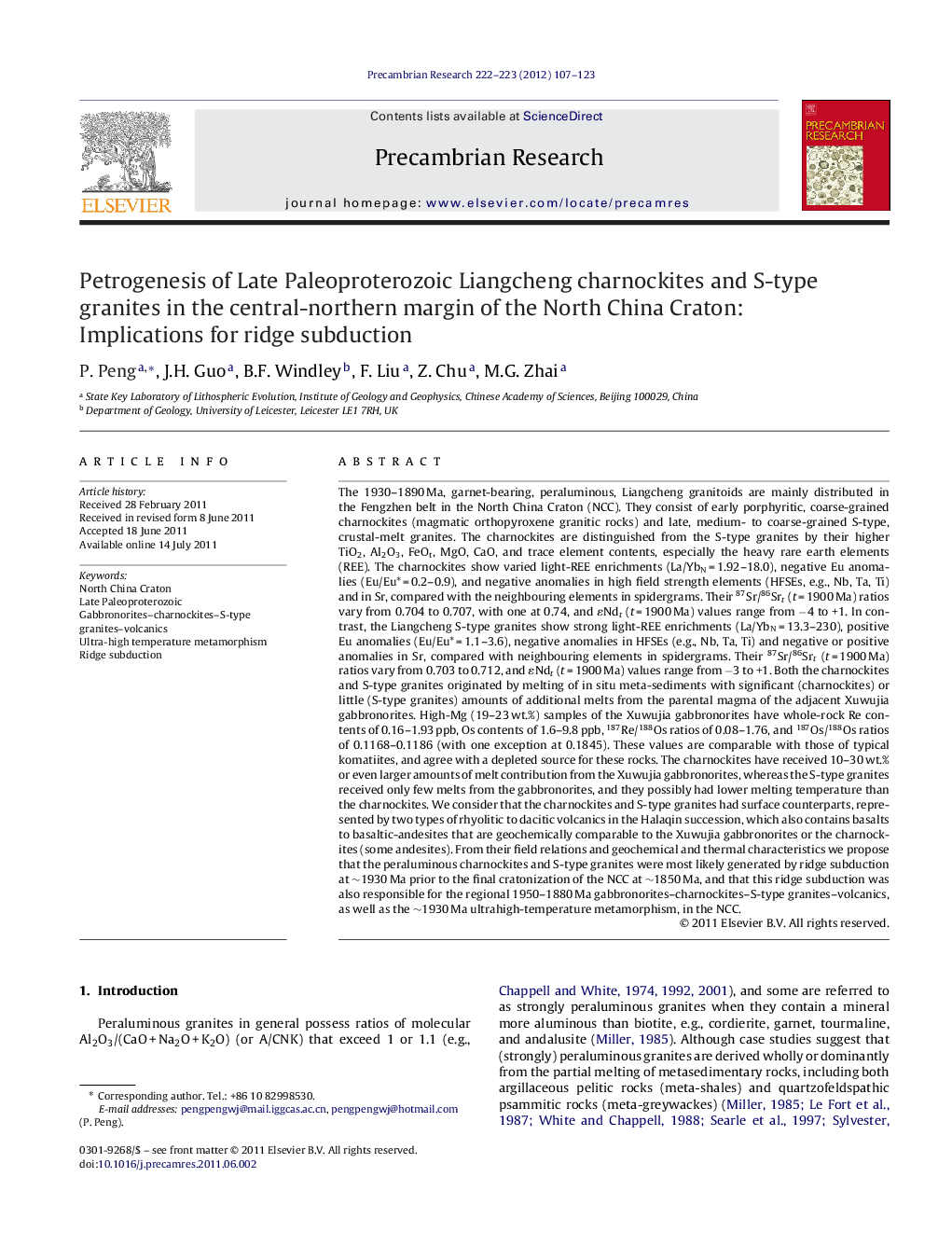| کد مقاله | کد نشریه | سال انتشار | مقاله انگلیسی | نسخه تمام متن |
|---|---|---|---|---|
| 4723444 | 1639651 | 2012 | 17 صفحه PDF | دانلود رایگان |

The 1930–1890 Ma, garnet-bearing, peraluminous, Liangcheng granitoids are mainly distributed in the Fengzhen belt in the North China Craton (NCC). They consist of early porphyritic, coarse-grained charnockites (magmatic orthopyroxene granitic rocks) and late, medium- to coarse-grained S-type, crustal-melt granites. The charnockites are distinguished from the S-type granites by their higher TiO2, Al2O3, FeOt, MgO, CaO, and trace element contents, especially the heavy rare earth elements (REE). The charnockites show varied light-REE enrichments (La/YbN = 1.92–18.0), negative Eu anomalies (Eu/Eu* = 0.2–0.9), and negative anomalies in high field strength elements (HFSEs, e.g., Nb, Ta, Ti) and in Sr, compared with the neighbouring elements in spidergrams. Their 87Sr/86Srt (t = 1900 Ma) ratios vary from 0.704 to 0.707, with one at 0.74, and ɛNdt (t = 1900 Ma) values range from −4 to +1. In contrast, the Liangcheng S-type granites show strong light-REE enrichments (La/YbN = 13.3–230), positive Eu anomalies (Eu/Eu* = 1.1–3.6), negative anomalies in HFSEs (e.g., Nb, Ta, Ti) and negative or positive anomalies in Sr, compared with neighbouring elements in spidergrams. Their 87Sr/86Srt (t = 1900 Ma) ratios vary from 0.703 to 0.712, and ɛNdt (t = 1900 Ma) values range from −3 to +1. Both the charnockites and S-type granites originated by melting of in situ meta-sediments with significant (charnockites) or little (S-type granites) amounts of additional melts from the parental magma of the adjacent Xuwujia gabbronorites. High-Mg (19–23 wt.%) samples of the Xuwujia gabbronorites have whole-rock Re contents of 0.16–1.93 ppb, Os contents of 1.6–9.8 ppb, 187Re/188Os ratios of 0.08–1.76, and 187Os/188Os ratios of 0.1168–0.1186 (with one exception at 0.1845). These values are comparable with those of typical komatiites, and agree with a depleted source for these rocks. The charnockites have received 10–30 wt.% or even larger amounts of melt contribution from the Xuwujia gabbronorites, whereas the S-type granites received only few melts from the gabbronorites, and they possibly had lower melting temperature than the charnockites. We consider that the charnockites and S-type granites had surface counterparts, represented by two types of rhyolitic to dacitic volcanics in the Halaqin succession, which also contains basalts to basaltic-andesites that are geochemically comparable to the Xuwujia gabbronorites or the charnockites (some andesites). From their field relations and geochemical and thermal characteristics we propose that the peraluminous charnockites and S-type granites were most likely generated by ridge subduction at ∼1930 Ma prior to the final cratonization of the NCC at ∼1850 Ma, and that this ridge subduction was also responsible for the regional 1950–1880 Ma gabbronorites–charnockites–S-type granites–volcanics, as well as the ∼1930 Ma ultrahigh-temperature metamorphism, in the NCC.
► ∼1900 Ma charnockites-S-type granites are identified in the North China Craton.
► S-type granites were derived from in situ metasediments.
► Charnockites incorporated melts from both metasediments and gabbronoritic melts.
► Gabbronorites–charnockites–S-type granites–volcanics constitute a cogenetic series.
► Magmatism and regional UHT metamorphism were produced by ridge subduction.
Journal: Precambrian Research - Volumes 222–223, December 2012, Pages 107–123